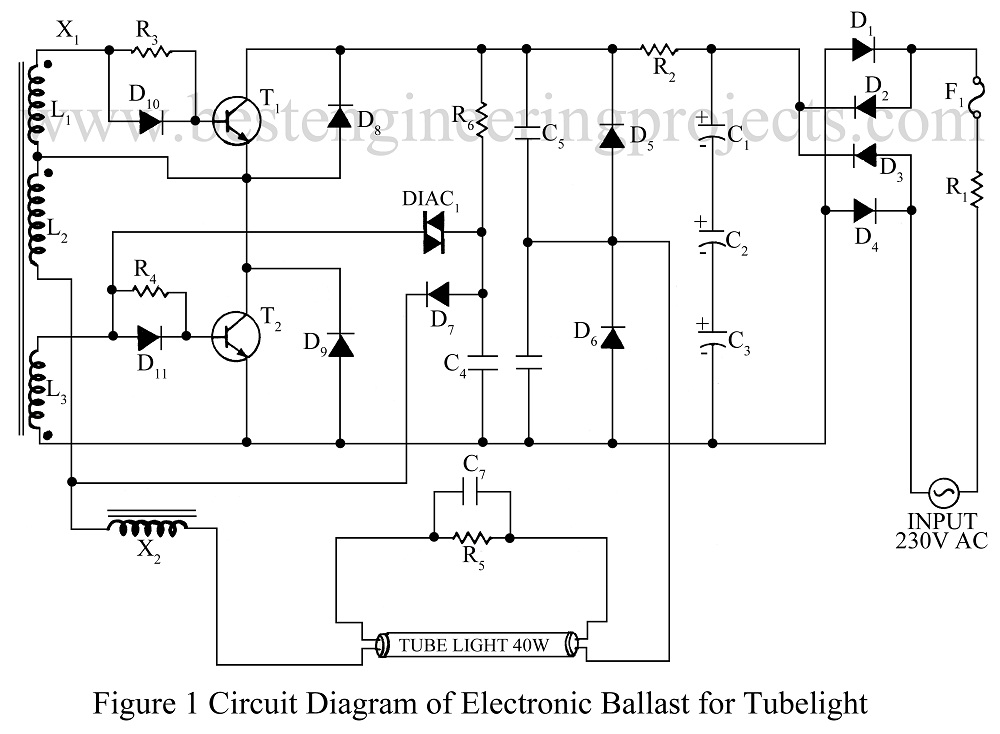The fluorescent tube-light requires additional gear such as the copper ballast and starter for normal operation. These two are required to provide the initial high voltage for ionization and thereafter to limit the current through the tube to safe values. It has been observed that the illumination efficiency of the tube-light when excited by high frequency power source is higher than that when excited at the 50Hz line frequency. Moreover, the power factor and the efficiency of the bulky copper ballasts are poor. Hence, electronic ballasts circuit were developed to overcome these deficiencies.
Description of Electronic Ballast Circuit
The electronics ballast circuit is light in weight, compact and has a high power factor. It starts up even at low voltage, and above all has a very high efficiency.
The typical electronic ballast is a current fed oscillator in the half bridge configuration. Transistors T1, T2 and capacitors C5, C6 form the half bridge in the circuit electronic ballast for tube light. Diodes D8, D9, D5, D6 clamp the output voltage values within the supply rails. Diodes D1 to D4 and capacitors C1 to C3 provide the required DC voltage for the circuit. Transformer X2 regulates the current through the tube and also determines the frequency of operation of the electronic ballast. For the value shown, the operating frequency is typically 25 to 30 kHz, R6, C4 and DIAC1 (DB-3) from the start-up circuit.
As capacitor C4 charges up to approximately 35V, DIAC1 provides a current pulse to the base of transistor T2, setting the circuit into oscillation. The specifications of transformer X1 and X2 are given below:
The transistors may be sorted by their current gain. The transistor with the similar current gain can be used. Use a digital multimeter with transistor check facility for this.
PARTS LIST OF ELECTRONIC BALLAST CIRCUIT
|
Resistors (all ¼-watt, ± 5% Carbon unless stated otherwise) |
|
R1, R2 = 1.5 Ω R3, R4 = 5.1 Ω R5 = 330 KΩ, 0.5W R6 = 470 KΩ |
|
Capacitors |
|
C1-C3 = 22 µF/160V C4 – C6 = 0.01 µF/630V C7 = 0.01 µF/1500V |
|
Semiconductors |
|
T1, T2 = MJE13005 D1 – D6 = 1N4007 D7 – D9 = BA159 D10, D11 = 1N4148 DIAC1 = DB-3 |
|
Miscellaneous |
|
X1 = coil wound on ferrite t-10 or T-12 core. 6 turns, 3 turns and 6 turns wound by thin plastic coated copper wire. The different winding should show insulating in excess of 100 MΩ at a test voltage of 500V. X2 = 160 turns of 29 SWG enameled copper wire with a sheet of thin insulating paper between layers. The E-25 ferrite core is fixed with a small air gap of about 0.2mm produced by paper kept between the faces of the ferrite core. F1 = 1Amp fuse 40W tube light |
WARNING: All component of the ballast are live. They carry high voltage. Direct contact with the circuit may prove lethal.
Disconnect the mains whenever possible and discharge capacitors C1, C2, C3 before testing the components. Use a 100-ohm resistor connected in between two probes to discharge, Do not discharge by shorting the capacitors.
MAJOR FAULTS | Electronic Ballast Circuit
Listed below are some of the major faults diagnosed in electronic ballasts along with the probable causes.
| S.N | Faults | Causes |
| 1 | Tube does not start or flickers: | Improper DIAC1 |
| Wrong sequence of connection for coil X1 | ||
| 2 | Tube flickers but does not start up: | Wrong connection of coil X1 |
| Faulty diodes D6, D5 | ||
| 3 | Tube operates, transistor overheat: | Poor insulation in X1 or incorrect no. of turns |
| 4 | Tube operates, coil X2 overheats: | Too high an air-gap |
| 5 | Hissing sound or crackling sound: | Improper insulation of coil X2 |
| 6 | Flickering tube: | Faulty capacitors C1, C2, C3 |
| 7 | Does not start-up at low voltage: | Very low air gap in X2 |
For further experimentation capacitor C1, C2 and C3 can be replaced by a single 8 µF polyester capacitor. This increase size and cost. This model will withstand high temperature (outdoor application) and will have a long life.
Twin L-section filters consisting of inductors and capacitors and capacitors can be used on AC input side of the choke. This would suppress radio frequency interference (RFI). The coils may be of 15 turns on T-20 ferrite core. The capacitors may be 0.01 µF, 1000 volts.

light glow as well as my series lamp glow when ballast is connected with series test.plz suggest for correct
Sir can you explain what is ballast? if it is a circuit, please share its circuit diagram?
Thanks in Advance
Sir I didn’t know what is ballast and how we can use it? plz can you explain what is ballast? if it is a circuit, please share its circuit diagram?
Thanks in Advance
GRAET JOB &VERYGOOD THANKS ALOT